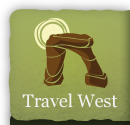St George Travel Tips
Travel Tips
Listed below are tips for your visit to the St. George area. Many are for outdoor activities in the area, but others are for more general needs.
Suggested Itineraries:
Here are three one day itineraries. You can use any of these for a day or use any combination of them for two or three day stays.
Day 1
Morning: Hike or bike in Snow Canyon State Park
Afternoon: Outlet shopping
Evening: Watch a play at Tuacahn or the St. George Musical Theater
Day 2
Morning: Play a game of golf
Afternoon: Go swimming at the St. George City Pool or the Sand Hollow Aquatic Center
Evening: Catch a softball game at The Canyons Softball Complex
Day 3
Afternoon: Visit the Johnson Dinosaur Discovery Site and the St. George Art museums
Evening: Splurge on a swanky dinner at The Painted Pony or Scaldoni's followed by getting some great ice cream at Blue Bunny
St George Area:
General Tips:
- Dress in layers anytime of the year (temperatures may differ with other regional cities)
- Prepare to acclimate with the altitude as many area attractions are at a much higher elevation than St. George
- Since St. George has about 300 sunny days a year, use sun protection (see section below)
- Drink plenty of fluids because St. George has a hot, dry climate
- Book rooms in advance because area hotels are usually sold out - click here for St. George lodging information
- Make activity and entertainment reservations in advance so that you have a solid itinerary before you get here - click here for St. George activity and entertainment information
- Plan where you are going to eat - click here for St. George dining information
- Consider Utah's liquor laws. For instance, the drinking age is 21, and minors have restricted access to private venues that serve alcohol.
Suggested Clothing:
- Bandanna (face, head and/or neck covering)
- Cut-off pants (hiking)
- Gloves (night/morning wear)
- Hat (sun & weather protection)
- Jacket (Warmth - wool/synthetic fiber and/or cotton)
- Jacket (wind breaker)
- Pants (heavy duty for outdoors)
- Rain wear (rain suit/poncho)
- Shirts (long sleeve for outdoors)
- Shoes (sport/hiking)
- Socks (cotton/wool or combination for hiking - one pair for each day)
- Sweatshirt/sweater/or down vest
- "T" Shirts (long or short sleeve)
- Underwear (depends on season/altitude for warmth - 20 to 55 degree/night wear)
- Warm, long sleeve shirt
First Aid:
One thing that should be at the top of any back country travel checklist is a personal first-aid kit, or a selection of medical supplies to meet emergency medical needs. What you should take will depend on who you are, where you are going and how long you will be staying. Consult your family doctor about these and any other suggestions and additional supplies you may need.
We would suggest the following minimum items be considered:
- Antiseptic
- Ace bandage
- Band-aids
- Burn ointment
- Chapstick
- First aid tape
- Foot (blister) pads/powder
- Gauze compresses
- Salt tablets
- Sharp knife
- Suntan lotion
Miscellaneous:
- Compass
- Day pack with (2 qts of water)
- Ear Plugs
- Eye Wash
- Fire starter
- Survival blanket
- First aid kit (See 1st Aid)
- Flashlight/extra batteries
- Matches (water proof)
- Paper/pencil
- Pocket knife
- Sewing kit
- Soap (washing & hand - biodegradable)
- Sun Glasses
- Toilet paper (In plastic packets)
- Towels (Wet)
- Water containers (two, 1 quart bottles)
Sun Protection:
- Keep in mind that the ultraviolet radiation of the sun which will burn you is stronger at higher elevations and are most intense in tropical, snow and water environments. Wear protective hats and other coverings when in the sun. A natural suntan which has been obtained slowly helps protect you from sunburn, however, the kind of tan you get from a bottle doesn't.
- When you buy a commercial sunscreen product look for a SPF (sun protection factor) rating on the package.
- SPF 2 to 4 = Minimal protection for people who rarely burn and tan easily and deeply.
- SPF 4 to 6 = Moderate protection for people who tan well with minimal burn.
- SPF 6 to 8 = Extra protection for people who burn moderately and tan gradually.
- SPF 8 to 15 = Maximum protection from sunburning for people who always burn easily and tan minimally.
- RECOMMENDED - SPF 15 or greater = Ultra protection from sunburn, offers the most protection which permits no sun tanning for people who burn easily and never tan.
Toiletries:
- Laundry bag
- Mirror
- Sleep wear
- Sanitary supplies
- Shaving articles
- Sewing kit
- Soap
- Tooth brush & paste
- Towel (bath/hand)
- Wash cloth
- Wet towels
![]()
Did you like this page? Did you find it helpful? Please consider sharing.
